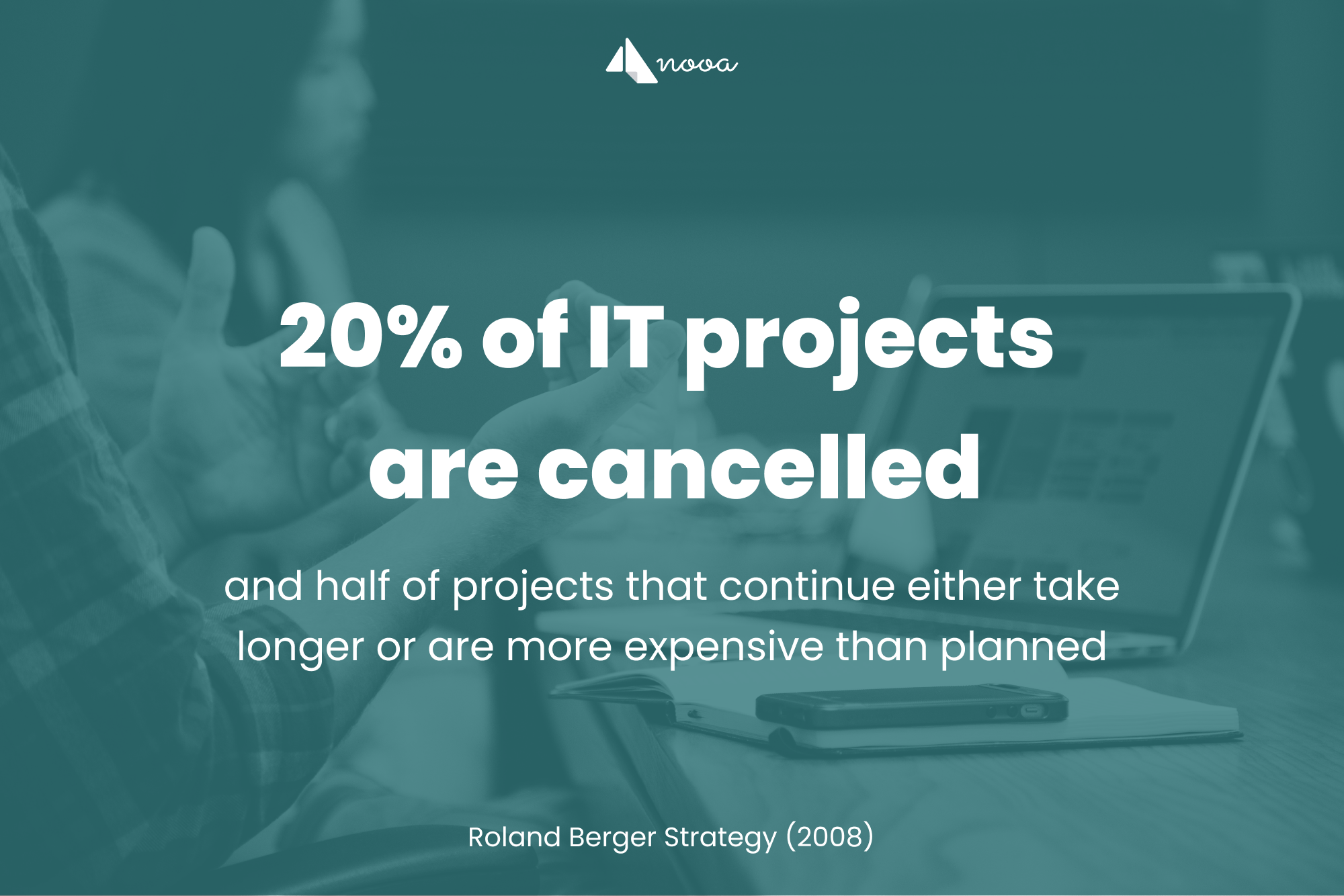Doomed to fail
A study by Roland Berger Strategy in 2008 found that more than 20% of all IT projects are cancelled. Furthermore, half of projects that continue either take longer or are more expensive than planned.

But what are the reasons for this disappointing fact? Experts cite various explanations, from the IT budget to the lack of know-how to an underestimation of change management needed. The most frequently mentioned reasons are:
-
Unclear goals and differing expectations: those responsible have different expectations and do not agree on the scope and goals of the project.
-
Lack of clarity around requirements: users are rarely included when the requirements are defined, setting the project up for a miss.
-
Project complexity is underestimated: resource availability and technical requirements often conflict, and the organisational effort is often underestimated.
-
Missing (human) resources: every project needs a person in charge and other staff to support them during implementation. With thin staffing, not enough effort is made to release employees from their day-to-day work.
-
Sticking to outdated technology: IT projects often fail because they are built on so-called a "legacy architecture". Attempting this means that software needs to be adapted in a tailored, complicated and time-consuming way - often causing additional costs and delays.
Good things come to those who wait... or not
Once these challenges are overcome, the next problem awaits: 52% of IT projects do not fully meet the requirements of the client (Standish Group, Chaos Report).

It is legitimate to ask why, after a large investment of time and money, the solution does not lead to the goal. We have identified three main reasons:
-
False promises from vendors with “lock-in effect”: vendors often hide weaknesses in order to win a contract. A well-known care software provider charges clients almost £13,000 before the software can even be used. Training courses, additional modules, monthly fees and costs for maintenance and support drive the bill even higher. Post-sale, if the software does not live up to the vendor’s promises, it is usually too late. Decomissioning the whole thing is unacceptable in terms of time and money, so you are stuck with a bad and overpriced solution i.e. you are "locked-in".
-
New software does not make up for missing processes: those responsible often try to hide the lack of processes by introducing new software, hoping that it will make up for the former. This is a fallacy.
-
Clinging to legacy systems: holding on to outdated systems must also be mentioned at this point. Once the project is completed, it is often found that the new tool can only handle about half of the tasks for which it was originally intended.
Whatever the reasons, the result is a solution that does not do what the user actually needs. This often leads to users only using parts of the new software or not using it at all - a "2nd degree failure".
So how can you ensure that your IT project is a success?
The good news: introducing software no longer has to be a big project
The (IT) world has changed
One piece of good news to start with: technology is different now than it was only a few years ago. In the past, companies had to install servers and software on-site. This is very time-consuming and expensive - servers have to be bought, housed, set up and maintained, usually by an expert. In addition to the initial cost for hardware and installation, maintenance and management will cost a considerable amount each month. While not only impacting profitability, it significantly complicates your IT project.
Comparing this to other technology, something is off: downloading apps on your phone, using them right away, logging into Facebook, Netflix, WhatsApp & Co. from any device without lengthy installation, training or a service partner is nothing special. Things simply work. But why can’t it always be this simple?
Megatrend Cloud
Today, the "cloud" offers new possibilities. It allows customers to focus on their core business, without having to worry about IT. All they need is a PC, tablet or mobile phone with access to the internet. Set-up time has fallen from several months to a few minutes and there is no need to invest in neither hardware nor IT departments, to hand-hold outdated and expensive systems.
Enter: "Agility”
According to a study by the Standish Group, agile projects are more successful.
So what does the word "agility" mean? Roughly speaking, it means testing in small steps whether something works or not. For example, when introducing new software, you can test it in a smaller group before rolling it out to the entire company. You can also try out core functionalities to check whether they meet your key requirements. As I am sure you noticed: it is important to use the software in advance, instead of relying on sales pitches and brochures.
The bottom line is that introducing new software no longer has to be a major project. This means less risk and higher chances of success.
Your checklist for new software
In the last step, go through the checklist below to guide you through the introduction of new software. This will help you ensure the success of your next project.
-
Set up clear processes: without processes, everything is chaos. Companies with structured processes are more likely to know what they need, and can look specifically for software that fulfills their requirements.
-
Go for standard products: do not develop custom solutions. For most problems, the wheel has already been invented. If you are unable to find a standard solution, take another look at your processes - they might need to be tweaked.
-
Define goals and a single point of contact: everyone involved must agree on what is the goal of the project. Identify a single point of contact who has the authority to make and execute decisions.
-
Involve users: users are usually reluctant to change and often prefer not to have new software at all. If you involve them early on, they can provide valuable contributions. Consider these, and the probability that the new solution will be adopted is significantly higher.
-
Do not hold on to legacy systems: go for modern, lean and, above all, cheaper alternatives. The cloud is the megatrend of the decade and will only grow in the future.
-
Test the product: whether via a product demo, a trial month or monthly cancellation, demand to test the product on the principle of agility to avoid nasty surprises.
-
Do not be afraid to cancel a project: if your project is not making progress, do not look at what you have already invested. If the probability of success is low, you risk only wasting more time and money. This is known as the "sunk cost fallacy".
Best of luck with your project!
